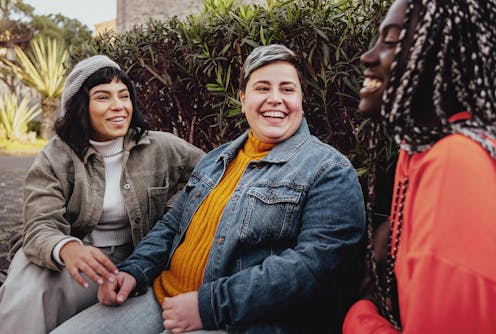
New data released by the Australian Bureau of Statistics (ABS) this week shows one in 20 (4.5%) Australians over 16 are LGBTQIA+.
For perspective: at around 900,000 people, that’s similar to the population of Tasmania and the Australian Capital Territory combined.
Yet in health and wellbeing outcomes – particularly mental health – this population drags far behind the rest of the country.
Last week the government released a landmark ten-year national action plan to address these health disparities for LGBTQIA+ people. Here’s why it’s needed – and what it hopes to achieve.
How many Australians are LGBTQIA+?
An accurate assessment of the number of LGBTQIA+ people in Australia has long been a critical gap in research due to limited reliable, population-level data.
This has meant LGBTQIA+ people, and their health needs, have often not been visible, particularly in outer suburbs and regional or rural areas. Services and supports can be inadequate as a result.
We don’t yet have census data about the LGBTQIA+ population. After years of community advocacy (and controversy over the government’s reversal and reinstatement of the questions) the 2026 census will be the first to ask Australians about their sexual orientation.
But this week the Australian Bureau of Statistics (ABS) released its first report on estimates and characteristics of LGBTQIA+ populations in Australia. These data were combined from four recent ABS health surveys.
The new data show 4.5% of Australians are LGBTQIA+. The percentage was higher among younger people – almost one in ten (9.5%) 16- to 24-year-olds, who are also at higher risk of poor mental health outcomes.
Why do we need a dedicated action plan?
While LGBTQIA+ people have been included as a priority population in other Australian health strategies, the new action plan is the first focused specifically on them.
The report highlights poorer self-rated health for LGBTQIA+ people as a key concern, as well as mental health and suicide outcomes, when compared to the population as a whole.
One in three (31%) LGBTQIA+ people self-rate their health as only “fair” or “poor” – double the general population (15%). This subjective assessment of health is recognised as a reliable predictor of future health.
Recent Australian data shows LGBTQIA+ people are more likely to be diagnosed with anxiety, depression or post-traumatic stress disorder. They have higher rates of self-harm and homelessness and are more likely to experience suicidal thoughts and behaviours.
For example, LGBTQIA+ adults have attempted suicide at over 17 times the rate of the general population (5.2% compared to 0.3% over a 12-month period).
A smaller body of data shows these mental health impacts are heightened for some sections of the LGBTQIA+ community. These include people with intersex variations, trans and gender diverse people, people living with disability, and Aboriginal and Torres Strait Islander people.
Why do LBTQIA+ people have poorer health?
These health disparities are not inherent to being LGBTQIA+. The evidence shows they are instead driven by social factors, such as rejection from families, experiences of harassment and discrimination, and lack of support within schools and communities.
When accessing health care and other support services, LGBTQIA+ people face multiple barriers which may further exacerbate gaps in health and wellbeing.
This may include a lack of LGBTQIA+ affirming care options. For example, health services may not ask about sexuality or gender identity on intake forms. This places the onus on LGBTQIA+ people to “out” themselves, which can be stressful and lead people to avoid health care.
Or it might involve accidental or overt discrimination, such as deliberate misgendering (referring to someone in a way that doesn’t reflect their gender identity) or outright refusal of service.
In some cases, health-care providers may draw on harmful stereotypes, such as negative ideas about LGBTQIA+ people and promiscuity, rather than focusing on the presenting needs of individual patients.
What will the action plan do?
Reducing stigma and discrimination requires changes in organisational culture and processes in health systems.
The National Action Plan acknowledges this requires considered action and investment to improve outcomes over the longer term. It aims to enhance access to inclusive health care and improve health literacy for LGBTQIA+ people.
For example, this will include ensuring LGBTQIA+ people are included in policy development and service planning across a range of health areas. It will also involve health education campaigns for LGBTQIA+ communities to encourage engagement in preventative health care.
The strategy prioritises workforce training and expanding research to address gaps in knowledge about this population.

Has LGBTQIA+ health improved with law reform?
LGBTQIA+ people report better health in jurisdictions where they receive greater legal protections and stigma is lower.
In recent decades, Australia has seen significant legal and cultural reforms to ensure recognition and equal rights are afforded to LGBTQIA+ people.
However, discrimination and stigma against sexual and gender minorities is far from eradicated. We are currently witnessing a global backlash against LGBTQIA+ rights.
In the United States in 2023, there were 75 instances of law change enacted to redact or remove LGBTQIA+ rights or visibility. This included banning classroom teaching on gender and sexual diversity and restricting access to public bathrooms for trans people.
Australia has also felt the impact of this backlash.
In 2023, “drag story time” events encountered threats of violence. In this same year a formal ball for young LGBTQIA+ people in Wangaratta was cancelled due to fears for participants’ safety.
Gains made toward greater equity in health outcomes for LGBTQIA+ people can be undermined or reversed with shifts in political culture or pressure from conservative forces.
Australia’s national action plan goes a long way toward protecting and advancing LGBTQIA+ people’s health in a way that is sustainable. However, there is still a long way to go and ongoing political support for the plan will be fundamental to its success.
If this article has raised issues for you, or if you’re concerned about someone you know, call Lifeline on 13 11 14.
13YARN is a free and confidential 24/7 national crisis support line for Aboriginal and Torres Strait Islander people who are feeling overwhelmed or having difficulty coping. Call 13 92 76.
Jennifer Power receives funding from the Australian Research Council and the Australian Department of Health and Aged care.
Joel Anderson receives funding from the Australian Research Council and the Medical Research Futures Fund.
Natalie Amos receives funding from the Australian Department of Health and Aged Care, the Medical Research Future Fund and Thorne Harbour Health.
Ruby Grant has previously received funding from Thorne Harbour Health and the Tasmanian Government.
This article was originally published on The Conversation. Read the original article.







